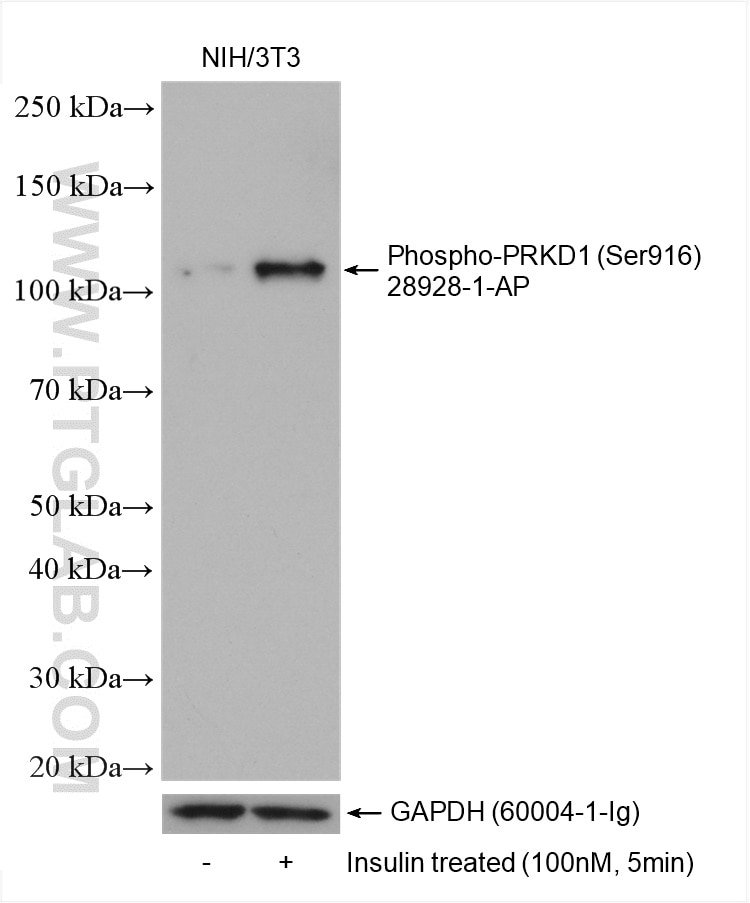Tested Applications
| Positive WB detected in | Insulin treated NIH/3T3 cells |
Recommended dilution
| Application | Dilution |
|---|---|
| Western Blot (WB) | WB : 1:500-1:2000 |
| It is recommended that this reagent should be titrated in each testing system to obtain optimal results. | |
| Sample-dependent, Check data in validation data gallery. | |
Published Applications
| WB | See 2 publications below |
Product Information
28928-1-AP targets Phospho-PRKD1 (Ser916) in WB, ELISA applications and shows reactivity with Human, Mouse samples.
| Tested Reactivity | Human, Mouse |
| Cited Reactivity | rat |
| Host / Isotype | Rabbit / IgG |
| Class | Polyclonal |
| Type | Antibody |
| Immunogen |
Peptide Predict reactive species |
| Full Name | protein kinase D1 |
| Calculated Molecular Weight | 102 kDa |
| Observed Molecular Weight | 110 kDa |
| GenBank Accession Number | NM_001330069 |
| Gene Symbol | PRKD1 |
| Gene ID (NCBI) | 5587 |
| RRID | AB_2918215 |
| Conjugate | Unconjugated |
| Form | Liquid |
| Purification Method | Antigen affinity purification |
| UNIPROT ID | Q15139 |
| Storage Buffer | PBS with 0.02% sodium azide, 50% glycerol, and 0.05% BSA, pH 7.3. |
| Storage Conditions | Store at -20°C. Stable for one year after shipment. Aliquoting is unnecessary for -20oC storage. |
Background Information
Protein kinase D1 (PRKD1), also named as PKD1 and PKCμ, is comprised of two cysteine-rich domains and a pleckstrin homology (PH) domain. PKD1 is involved in cellular processes including protein secretion, proliferation, cytoskeletal reorganization, Golgi function, immune function and apoptosis. It is widely expressed in thyroid, brain, heart, lung and other tissues. PKCs have been shown to regulate PKD1 activation. It has been reported that ser 916 is a PKD1 autophosphorylation site. PKD1 can be activated by growth factors, oxidative stress, thrombin, bioactive lipids, cross-linking of B- and T-cell receptors and some G-protein coupled receptors (GPCR). PKD1 is located mainly in the cytoplasm in unstimulated cells, while PKD1 migrates to the membrane in activated cells. (PMID: 17306383, 24806360, 30101477, 21696630)
Protocols
| Product Specific Protocols | |
|---|---|
| WB protocol for Phospho-PRKD1 (Ser916) antibody 28928-1-AP | Download protocol |
| Standard Protocols | |
|---|---|
| Click here to view our Standard Protocols |
Publications
| Species | Application | Title |
|---|---|---|
Food Chem Toxicol G-Rh4 improves pancreatic β-cells dysfunction in vivo and in vitro by increased expression of Nrf2 and its target genes. | ||
Biochem Biophys Res Commun Protein kinase D1 promotes the survival of random-pattern skin flaps in rats |




